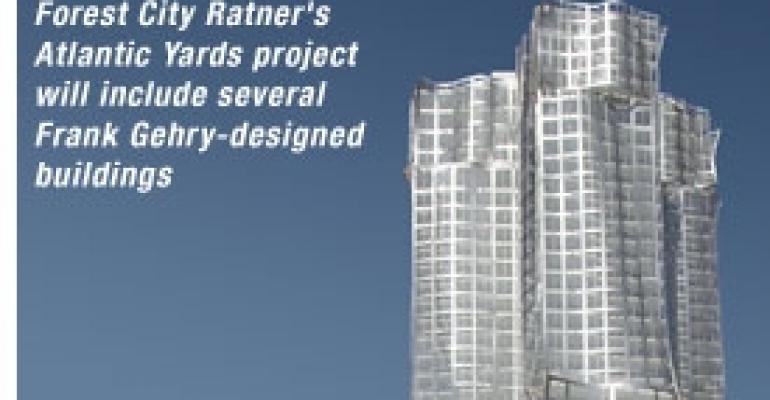Change orders are a headache for any real estate developer. But when you’re a mixed-use developer, those headaches can become migraines because of the difficulty of keeping tabs of the various office, residential and retail contractors and subcontractors. One change order that slips through the cracks can add up to millions of lost dollars.
With about $6 billion in mixed-use projects underway, Forest City Ratner Cos. wanted to make sure it wasn’t bleeding money at the hands of contractors and subcontractors. So to help keep a closer eye on change orders, and various other aspects of its mixed-use projects, Forest City Ratner this month installed Proliance real estate management software from Meridian Project Systems Inc. at a cost of about $1 million, says Raj Patel, senior vice president and chief information officer at Forest City Ratner.
Among other things, the Proliance software enables electronic workflow instead of paper shuffling, and establishes a computerized audit trail for construction changes and approvals. Trimming costs on just one questionable change order could pay for the cost of the software, Patel says.
 “If you’re not watching the change orders, you’ll realize at the end of the project, when it’s too late, that you’ve busted your budget,” Patel says. On a $300 million to $400 million project, change orders eventually can result in a “bust” of $2 million to $5 million, he says.
“If you’re not watching the change orders, you’ll realize at the end of the project, when it’s too late, that you’ve busted your budget,” Patel says. On a $300 million to $400 million project, change orders eventually can result in a “bust” of $2 million to $5 million, he says.
Without any one-size-fits-all software programs on the market, mixed-use developers such as Forest City Ratner are embracing a patchwork approach by using a variety of software products to help juggle the myriad pieces of these complicated, costly projects.
Change orders are common at a company like Forest City Ratner, which currently is involved in four mixed-use projects totaling nearly $6 billion, among them the $4.1 billion, 21-acre Atlantic Yards project in Brooklyn, N.Y. Relying on the new software, “if we can just save 1% on that,” Patel says of the $6 billion figure, “it’s a huge return.” Forest City Ratner is a Brooklyn-based unit of Cleveland-based Forest City Enterprises Inc. (NYSE: FCE-A).
Proliance replaces three less efficient, disconnected software systems from other vendors, according to Patel. The new software is being integrated with existing Open Text Livelink document management software and SAP financial management software.
The Proliance software permits Forest City Ratner to detail an array of project expenses, such as steel and concrete, according to each mixed-use component (office, residential or retail) or even down to one element like a retail store or a hotel. The software “lets you slice and dice the data very well,” Patel says.
John Goff, senior vice president of development at Cousins Properties Inc. of Atlanta, says the real estate company hasn’t encountered an out-of-the-box “mixed-use projects-R-us” software product. To better manage its mixed-use projects, Cousins meshes a 30-megabyte Excel spreadsheet program to track financial performance with an Argus software program to calculate cash-flow projections and a project management product called MS Project. One key benefit of this software setup is that it allows Cousins to pinpoint investment returns for a project that may take five to 10 years to finish, he says.
Cousins (NYSE: CUZ) is employing that software hybrid for its $660 million, 2.3 million sq. ft. Terminus mixed-use project in Atlanta’s Buckhead area. In a similar yet less sophisticated fashion, Goff says, the software amalgamation aided Cousins’ 1 million sq. ft. Gateway Village mixed-use project in Charlotte, N.C., which was completed in 2001.
“The trick with a mixed-use project on a software basis, is to understand how your cash flow works over time,” Goff says. The software system helps Cousins see the long-term effects of its decisions. For instance, it can guide the company in deciding whether to earmark $1 million for engineering a stormwater system at a mixed-use project. “You may be crazy to spend the $1 million now or it may be the best $1 million you ever spent,” Goff says.
At Steiner + Associates Inc. of Columbus, Ohio, real estate management software from Intuit Real Estate Solutions prevented the real estate developer and manager from having to recruit another person for its leasing operation, CFO Laura Wedekind says. After adding residential to its office and retail mix in 2004 and opening two mixed-use projects this year, Steiner + Associates weighed hiring someone to assist with lease administration. But the company was able to delegate the job to its attorneys, who also have access to the software.
About 50 to 75 people use the Intuit software, which Steiner + Associates leases monthly for $200 to $400 per person, Wedekind says. The software includes leasing, budget, job-flow and job-cost features.
Despite growing interest in mixed-use developments, one software and real estate expert doesn’t foresee one-size-fits-all software products being tailored for mixed-use developers. Instead, Robert Cummings thinks you’ll see more technological creativity on the part of mixed-use developers and their software consultants.
Only about one-fifth of the functionality of software programs actually is tapped by users, primarily because a lack of training, says Cummings, product manager for the Skyline software line at SS&C Technologies Inc. of Windsor, Conn. Owners and managers install Skyline for lease administration and management at commercial, retail and residential properties.
Cummings says that although there’s a perceived need for a unified software program aimed at mixed-use projects, the software marketplace couldn’t sustain such a product, given the fact that there are only dozens — not thousands — of mixed-used developers around the country. For software makers, he says, “there’s not a big enough problem to warrant an investment.”
